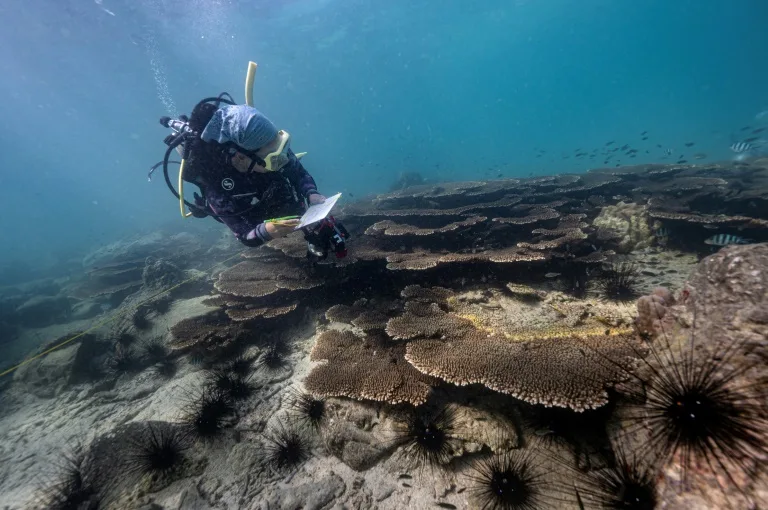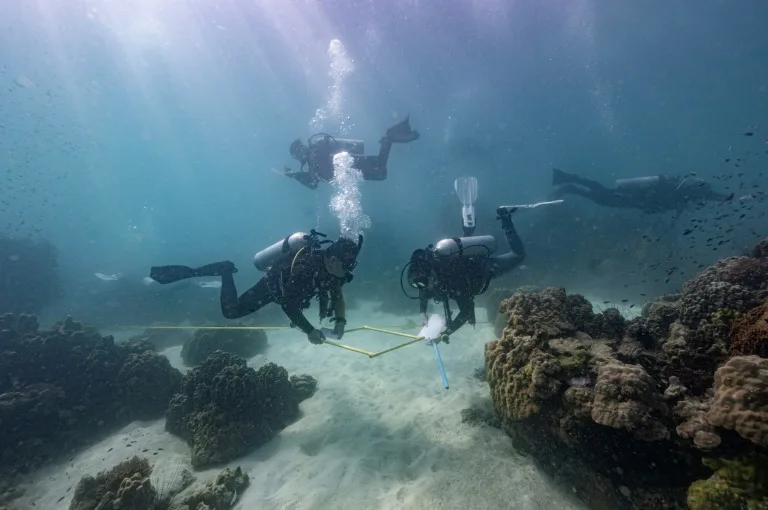Learning
Coral Reefs in the Gulf of Thailand Dying from Yellow-Band Disease
A rapidly spreading disease is killing corals across vast stretches of the sea floor beneath the calm turquoise waters off eastern Thailand, and scientists fear it will worsen due to climate change.
Yellow-band disease, so named because of the color it turns corals before destroying them, was discovered decades ago and has caused widespread damage to Caribbean reefs. There is no known treatment.
However, it was discovered for the first time last year off Thailand’s eastern coast, near the popular tourist destination of Pattaya, and has already spread over 600 acres (240 hectares) of sea.
“I’ve never seen anything like this before,” said Lalita Putchim, a marine scientist with Thailand’s Department of Marine and Coastal Resources.
“We saw it everywhere we went, and we expect to see more of it as we go.”

Overfishing, pollution, and rising water temperatures due to climate change, according to scientists, may be making the reefs more vulnerable to yellow-band disease.
Unlike the effects of coral bleaching, the disease’s impact cannot be reversed.
“When the coral becomes infected with this disease, it simply dies,” Lalita explained.
The loss of corals could have a devastating impact on the ecosystem because the reef is “like a forest,” supporting massive amounts of life, and its demise could eventually affect humans as well, she added.
Thai scientists are hoping that their investigation into this outbreak will lead to a cure or prevention of yellow-band disease.
Lalita and her team donned diving gear on a boat before heading underwater on a research trip near Samaesan island in Chonburi district. They took measurements and photographs of infected corals while harvesting samples for later study.

Thai marine authorities are tracking reports of infected reefs on social media and have asked the public to report any sightings of affected corals. Local volunteers and business owner Thanapon Chaivanichakul assisted Thai researchers by collecting underwater photographic evidence.
“I was shocked when I first saw it,” Thanapon said, describing the disease with a string of expletives. The disease also threatens the livelihoods of many people in the area.
Choopan Sudjai, the owner of a sightseeing boat, depends on tourists who come to see the natural beauty of the area, particularly the coral reefs.
“What will we do in five years now that the coral has been infected and will be destroyed?” the 55-year-old asked. “It feels like our house has been destroyed.”
Yellow Band Coral Disease
Coral diseases are typically caused by biological stresses such as bacteria, fungi, and viruses, as well as nonbiological stresses such as rising sea surface temperatures, ultraviolet radiation, and pollutants. One type of stress may aggravate another.
Over the last decade, the frequency of coral diseases has increased significantly, resulting in widespread mortality among reef-building corals. Many scientists believe the rise is due to deteriorating water quality caused by man-made pollutants and rising sea surface temperatures.
Microbes may be able to multiply and colonize as a result of these factors. However, the precise causes of coral diseases remain unknown. Most diseases are likely the result of a combination of factors.
While the pathologies or mechanisms by which many diseases act on coral polyps are unknown, the effects of these diseases on corals have been well documented. Yellow-band disease manifests itself as discolored bands, spots, or lesions on the coral’s surface.
These move across or expand across the coral’s surface over time, consuming living tissue and leaving a stark white coral skeleton in their wake.
Yellow-band disease spreads quickly across a coral, destroying the delicate underlying tissues. On the left is a massive coral that is being attacked by yellow-band disease.
The same coral is shown on the right several weeks later. Take note of how quickly the area of destroyed tissue has grown.































